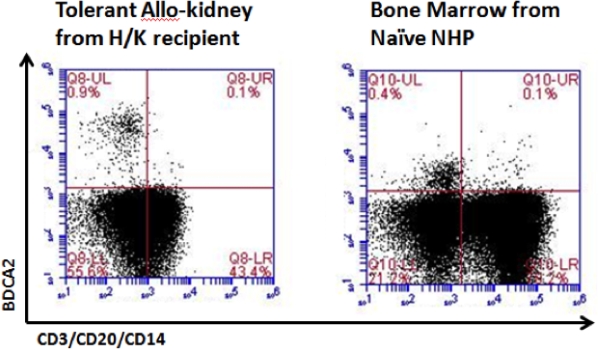Kidney Plasmacytoid Dendritic Cells Display Distinct Cell Surface Markers and May Explain the Induction of Tolerance by Kidney Allografts
Massachusetts General Hospital, Boston, MA.
Meeting: 2015 American Transplant Congress
Abstract number: 423
Keywords: FACS analysis, Graft survival, Heart, Tolerance
Session Information
Session Name: Concurrent Session: Transplant Tolerance: Animal Models II
Session Type: Concurrent Session
Date: Tuesday, May 5, 2015
Session Time: 2:15pm-3:45pm
 Presentation Time: 3:03pm-3:15pm
Presentation Time: 3:03pm-3:15pm
Location: Room 118-C
Achieving tolerance in heart allografts is an important area of research as the need for heart transplantations increase. Recent studies in non-human primates (NHPs) have demonstrated co-transplantation of kidney and heart allografts from the same donor leads to the acceptance of the heart allograft. Murine studies have demonstrated the spontaneous acceptance of full MHC-mismatched kidney allografts. We observed that DBA/2 kidneys transplanted into B6.¯o;MT mice (B-cell deficient) are spontaneously accepted and found B220+ cells localized around distinct Treg-rich organized lymphoid structures which, in the absence of B cells, can be interpreted as plasmacytoid dendritic cells (pDCs). Flow cytometric analysis from a DBA/2 kidney accepted by a B6 WT recipient confirmed the presence of pDCs. This study is focused on understanding this apparent systemic tolerization by the kidney and the role of kidney pDCs in this process, especially because immature pDCs have been shown to participate in regulatory and deletional tolerance.
In our study, we observed distinctive characteristics between kidney pDCs and bone marrow pDCs. In a mixed-chimeric NHP tolerant to heart and kidney allografts, we found that pDCs from the tolerant kidney were BDCA2hi (cell marker unique to pDCs in primates) in contrast to bone marrow pDCs in naïve NHPs, which were BDCA2low. Similarly, naïve kidney pDCs in DBA/2 mice were found to be B220low and PDCA1low (cell marker unique to pDCs in mice), whereas naïve DBA/2 bone marrow pDCs were B220hiPDCA1hi. These DBA/2 kidney pDCs cultured with naïve B6 T-cells, IL-2, and TGF-β were able to convert naïve T-cells into FoxP3+ Tregs.
The distinctness in kidney pDCs may be evidence of its ability to induce tolerance and may explain heart allograft acceptance in the context of heart/kidney co-transplantation in NHPs, as well as spontaneous kidney allograft acceptance in mice. While we are currently obtaining more data to understand these observations, we are convinced that kidney pDCs have inherently different properties that contribute to inducing tolerance in NHP and mice.

To cite this abstract in AMA style:
Oh N, Tonsho M, Ndishabandi D, Colvin R, Madsen J, Alessandrini A. Kidney Plasmacytoid Dendritic Cells Display Distinct Cell Surface Markers and May Explain the Induction of Tolerance by Kidney Allografts [abstract]. Am J Transplant. 2015; 15 (suppl 3). https://atcmeetingabstracts.com/abstract/kidney-plasmacytoid-dendritic-cells-display-distinct-cell-surface-markers-and-may-explain-the-induction-of-tolerance-by-kidney-allografts/. Accessed December 29, 2025.« Back to 2015 American Transplant Congress
